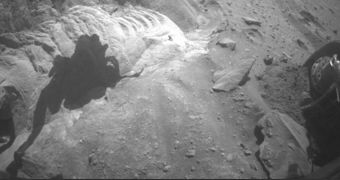In spite of promising results during the last drive attempts, the Mars Exploration Rover (MER) Spirit has now been transformed into a static scientific platform. Experts at NASA announce that they are dropping the rescue effort, which has been ongoing for the past ten months. Last May, the rover got trapped in a patch of loose Martian soil called Troy, and all drive attempts aimed at releasing it from its predicament have since failed.
“Spirit is not dead; it has just entered another phase of its long life. We told the world last year that attempts to set the beloved robot free may not be successful. It looks like Spirit's current location on Mars will be its final resting place,” NASA Headquarters MER Program Director Doug McCuistion says. Researchers add that the robot could endure at that particular location, the western edge of a low plateau called Home Plate, for months, or even years to come. As we speak, the robot is being prepared to face the coldness of winter on Mars.
It is currently mid-autumn on the Red Planet, and the amount of solar energy available is decreasing each day. Though they may have still had time to perform a few other drives before energy levels became insufficient, experts at the NASA Jet Propulsion Laboratory (JPL) decided to use the remaining time to reposition Spirit in the best possible configuration. This means that the machine will be tilted in a manner that will allow its solar panel to make the most of the reduced amount of sunlight that area of the planet will get over the coming months.
One of the main efforts underway now is tilting the rover correctly. Its tilt currently faces the South, but most of the time during the Martian winter, the Sun is in the northern sky. “We need to lift the rear of the rover, or the left side of the rover, or both. Lifting the rear wheels out of their ruts by driving backward and slightly uphill will help. If necessary, we can try to lower the front right of the rover by attempting to drop the right-front wheel into a rut or dig it into a hole,” JPL MER rover driver Ashley Stroupe explains.
“Getting through the winter will all come down to temperature and how cold the rover electronics will get. Every bit of energy produced by Spirit's solar arrays will go into keeping the rover's critical electronics warm, either by having the electronics on or by turning on essential heaters,” MER Project Manager John Callas, an expert at the JPL, explains. He has also been the leader of the amazing effort to save Spirit, which began in mid-2009, using a JPL sandbox and a test robot for the job. But, even with the sad news, there is some optimism among scientists as well.
“There's a class of science we can do only with a stationary vehicle that we had put off during the years of driving. Degraded mobility does not mean the mission ends abruptly. Instead, it lets us transition to stationary science. If the final scientific feather in Spirit's cap is determining whether the core of Mars is liquid or solid, that would be wonderful – it's so different from the other knowledge we've gained from Spirit,” the MER mission principal investigator, Cornell University expert Steve Squyres, says. MER also includes Spirit's twin rover, Opportunity, currently going about its business as usual on the other side of Mars.

 14 DAY TRIAL //
14 DAY TRIAL //